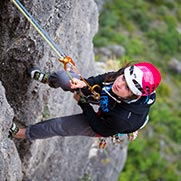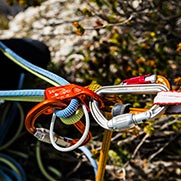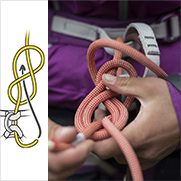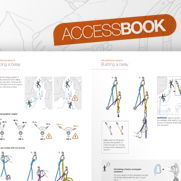Performance of new ropes
The sheath of a new rope can be slippery, requiring extra vigilance during the first uses.
Warnings
- Carefully read the Instructions for Use used in this technical advice before consulting the advice itself. You must have already read and understood the information in the Instructions for Use to be able to understand this supplementary information.
- Mastering these techniques requires specific training. Work with a professional to confirm your ability to perform these techniques safely and independently before attempting them unsupervised.
- We provide examples of techniques related to your activity. There may be others that we do not describe here.
A new rope gives reduced braking performance with devices such as GRIGRI, I’D, REVERSO, STOP, ZIGZAG and all descenders in general.
With assisted braking devices, the locking action is initiated by the rope rubbing against the braking parts.
With a more slippery rope, the device’s reaction time can be increased.
Actual locking is done by the rope being pinched, and is unaffected by the surface condition of the rope.
Descent control can also be more difficult, less fluid.
On braking devices without locking such as REVERSO, PIRANA or SIMPLE, you must grip the rope more tightly with your hand and rely less on the device to help slow the descent or stop a fall. A poor choice of rope diameter, an incorrect installation in the device or simply a lack of vigilance can become critical more rapidly with a new rope.
Note:
The locking performance of devices having a "toothed" cam such as ASAP, MICRO TRAXION, ASCENSION, BASIC, PRO TRAXION is the same whether the rope is new or used.
New rope used with your usual devices
When you are used to how your rope + braking device combination works together, a change of rope can be disconcerting, especially if your device is already a bit worn.
New ropes installed long-term for training
When a new rope is installed for an extended period in a training center, it can remain slippery for a longer time because by remaining hanging it is protected from dust, and is only used with clean devices, always in the same direction. It does not wear evenly and can have significant sheath slippage.
Warning: it is necessary to be extra vigilant if the new ropes are used by beginners.
What can be done?
When changing ropes, carry out a compatibility test with your braking device: check the locking effectiveness while belayed.
This test is formally described in the ZIGZAG Instructions for Use (for example) but can be done, at low height, with any device.
Add friction for the first uses of the rope: use a FREINO or a suitable technique for redirecting the rope.
If you are a beginner using a new rope, be very careful, be sure to use a suitable technique that is validated by a competent person.
Performance differences between nylon and polyester ropes
During the first uses, polyester rope is a little more slippery than nylon rope.
Afterward, polyester rope tends to remain more supple, and to age slower.







